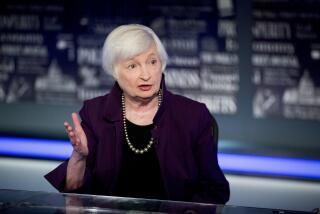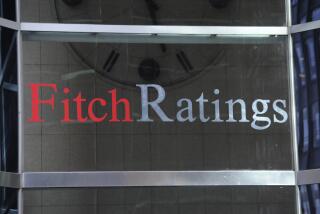S&P: Budget, debt fights unlikely to send U.S. credit rating down
WASHINGTON -- Standard & Poor’s said Monday that the current impasse over funding the federal government and raising the debt limit probably would not lead to another downgrade of the U.S. credit rating -- as long as the stalemate didn’t last long.
But a failure to raise the nation’s borrowing ceiling in time to avoid a first-ever federal government default would cause S&P to reassess its AA+ rating for the U.S., the company said in a report.
The Treasury Department has said the debt limit must be raised by Oct. 17 or the nation risks not having enough money to pay its bills on any given day.
S&P, one of the three leading credit-rating firms, downgraded the U.S. credit rating in 2011 after a last-minute deal ended a bitter stalemate over raising the debt limit. The company warned that Washington politicians were repeating their same mistakes.
“This sort of political brinkmanship is the dominant reason the rating is no longer AAA,” S&P said Monday.
QUIZ: Test your knowledge about the debt limit
Government defaults historically have led to low ratings once they have ended, ranging from B to CCC+, the company said.
But the U.S. situation would be unique because it would involve “political brinkmanship among branches of government” and a post-default rating would require an analysis of “the changes in the political and economic landscape,” S&P said.
S&P said it expected the debt limit to be raised. The effect of a government shutdown, which could begin Tuesday, would be assessed when the parameters of a closure were clear, the report said.
Still, the fiscal fighting “creates an atmosphere of uncertainty that could affect confidence, investment and hiring in the U.S,” S&P said.
In June, S&P upgraded its outlook for the U.S. rating to stable from negative because or more optimism about the nation’s economic outlook, including the falling budget deficit and a deal last winter to avoid the so-called fiscal cliff.
The change in the outlook meant there was less than a 33% chance the U.S credit rating would be downgraded in the next two years.
S&P said Monday there was a potential for more political compromise, but the continued political fighting on the budget and debt ceiling was one of the factors constraining the U.S. credit rating.
ALSO:
Is Cupertino sacrificing its core to Apple?
FHA to get $1.7 billion in its first taxpayer-funded bailout
Ride-sharing services get the green light, but will insurers follow?
More to Read
Inside the business of entertainment
The Wide Shot brings you news, analysis and insights on everything from streaming wars to production — and what it all means for the future.
You may occasionally receive promotional content from the Los Angeles Times.











